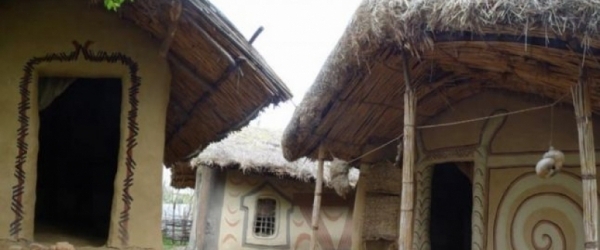
A Succesfull Project – a 6000 years old Village Reconstructed at Draganeshti, Olt County. Video documentary!
Posted by Bindiribli
7 mai 2014
A life-size Neolithic village in Draganeshti, Olt County, South of Romania was rebuilt on the precincts of the ‘Museum of the Boian Plain’; it is comprised of six life-sized huts.
The settlement was laid out on a field surrounded by a protection ditch and a fence, made by interlaced wickers, specific to the 6th millennia BC. The entrance to the settlement was possible due to a wooden deck. The interior of each hut has distinct areas: for living, for preparing the food and for the tools’ storage.
The founder of the project, mister Traian Zorzoliu (77 years old), director of the ‘Boian Plain’ Museum, built the huts according to the original „recipe”, meaning he used only adobe made of entwined reed, and wooden stakes implanted in the ground. The adobe was also filled with earth. The facades of the huts were also designed according to the specifics of the era. The lodgings were destined to various social categories: fishermen, farmers, potter men, hunters. Inside we can find Neolithic objects, and miscellaneous reconstructed tools, tables, and cult altars.
The museum was also able to rebuild a lacustrine dwelling house, used in the old days for the storage of victuals. This was needed due to the fact that the dwellings were built in valleys that used to be flooded all the times.
We also find here a grave with the specific details of this culture-having an oval pit hole (now covered in Plexiglas), and the original skeleton with its feet and arms bent in fetal position, specific to the religious beliefs of the time. In the archeological park of Draganesti – Olt, professor Zorzoliu succeeded to rebuild this village according to the details of the Gumelnitza culture whose artifacts were unearthed here.
A lane of the original village The originator of the project explains the purpose of the village that makes you travel back in time: „This Neolithic village represents exactly only one lane of the original village. During the original epoch, the settlements appeared first around 3 to 5 huts, built in flooded areas, on small islands. They used to slowly develop into villages. In order to successfully re-create the original atmosphere we have performed extensive research. The archeological park came to life with the help of the employees of the ‘Boian Plain’ Museum, that worked diligently day by day, for a whole year” mister Zorzoliu declared.
Transcript for the video bellow:
Folk outfits were found here, which are a mark for continuity. This is the mat I will show you the pictures, but we also found a bed covered with a mat. We found all of these during diggings in a specific area. We showed what we found to many specialists and they all agreed that this is the most authentic Neolithic village from the entire Europe.
This was the resting area, this was the sacred place.
These were shamanic censers – they found in Bulgaria very large pieces – and they were inhaling plants. In fact this is a cult table.
This was a shrine where they worshiped the gods of those times.
These are replicas of the pottery – we also have the original pieces. These are made together with the kids from the Children’s Palace in Slatina (we have an oven outside for pottery).
Nothing is invented; everything is an exact replica, based on the information gathered on the sites – the bed, the fireplace, the entire inventory.
Come take a look at the original pieces. Look, these are his original tools; we found them deep in the ground. Some were not molded, like weights for the weaving loom, where you can see the mark left by his fingers. These, for example, are his original molding tools.
-So these are all original?
-Yes, all of them are original tools. The knife, everything – well, this is a new handle on the knife. These are the original tools. They made these with shells, from these they made spatulas, look, I have several nice ones, which are grinded, to clean the bowls.
-And this is where he lived with his family?
– Yes. Let’s go. This is a hunter’s place. I wanted to divide them by trade.
-Tell us more about this place, please.
– He had bows with arrows (we don’t have the arrows anymore), daggers, baskets in which he carried his tools. Here is some fish (is still intact), so he was also a fisherman. There was the place to rest.
That is a rush light, let me show you the rush light (we also found several of these). Everything was quite basic, simple.
This is where he put the wick and here he dipped it into animal grease. This was actually his lamp.
This year we covered them with straws. We built small huts – in those times there were small huts, like these ones, but also larger ones, up to 6 meters long. We didn’t have enough space to build them in that size, but we worked with the technology used back then.
In the back there is a weaving loom.
– This must have been the house of a farmer?
– Yes, it was the house of someone who worked with the land, so what could he have inside other than wheat, primitive grinders (that one is an original piece). Everything was built in wood.
– They also had those benches to store their dishes.
Source: http://adevarul.ro/locale/slatina/video-foto–sat-vechi-6000-ani-reconstruit-ladraganesti-olt-1_51783628053c7dd83f4321d0/index.html
Via – Wonderful Romania Project
Arranged and translated: Talia
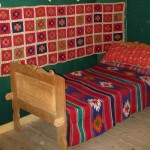


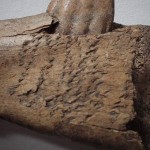




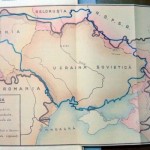


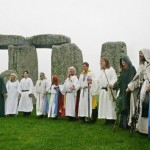








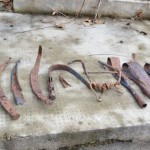
















Da mai departe